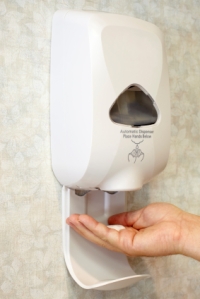CAUTION – Hand Sanitizers Can Have Hazards
 A recent news story (http://t.co/FdBNnIQ9vz) tells of a girl in a hospital who was burned when hand sanitizer ignited. First off, our hearts go out to that girl and her family. There is a kid who is fighting hard with a number of strikes against her and she still keeps on. All kids have a soft spot in firefighters’ hearts, but kids like this are deserving of extra care and prayer.
A recent news story (http://t.co/FdBNnIQ9vz) tells of a girl in a hospital who was burned when hand sanitizer ignited. First off, our hearts go out to that girl and her family. There is a kid who is fighting hard with a number of strikes against her and she still keeps on. All kids have a soft spot in firefighters’ hearts, but kids like this are deserving of extra care and prayer.
Hand sanitizer became a staple in hospitals several years ago. Studies reveal that hand-sanitizer helps reduce spread of disease in hospitals where patients are already compromised. The practice works.
At that time most hand sanitizers were alcohol-based and that created some heartburn for fire marshals across the U.S. Alcohol is readily ignitable and burns with a nearly invisible flame in daylight.
Most hospital patients are considered ‘non-ambulatory’. They’re usually not able to get up and quickly move to safety on their own. Fire codes provide special protection for non-ambulatory patients. That level of protection is not helped by the presence of oxygen (which greatly increases fire behavior) and flammable anesthetic gases. Fire codes address those added hazards and as a result hospitals are some of the most fire-safe buildings on the planet. Now hospitals wanted to store alcohol-based gels in each room as well as in corridors we fire marshals were designing to be fire safe? That sent everyone back to the drawing boards.
Recognizing the value of hand sanitizer for patient care, designers crafted safety features allowing hospitals to reap the benefits of hand sanitizers while preserving a level of fire safety that ensures everyone survives the fire hazards. Dispenser size was regulated, locations were specified, leaks and drips were addressed and generally everyone felt pretty safe about hospitals and hand sanitizers.
Then they showed up in schools. School nurses heard about the disease prevention success in hospitals and wanted that in schools. Good idea! They also showed up in retirement homes, colleges and grocery stores. Now you can find a hand sanitizer dispenser just about anywhere.
We need to remember that the product is still flammable and has inherent hazards. When used as designed, alcohol-based hand sanitizers should not be a problem. In the case of the recent news story, the hand sanitizer was reported to have been used to clean a shirt. That’s not what the designer intended hand sanitizer for. The shirt caught fire, probably from an accidental static electric discharge.
Many occupancies use non-alcohol based hand sanitizer to avoid fire hazards. Health care organizations indicate that may reduce the effectiveness of the disease prevention effort.
The moral of the story is that we must remain alert to the hazards present in all of the flammable and combustible liquids that we use every day. Failure to do so can lead to disastrous results. Stay alert to how you and your family use the flammable and combustible products in our daily lives. That way the fire department won’t have to get involved.